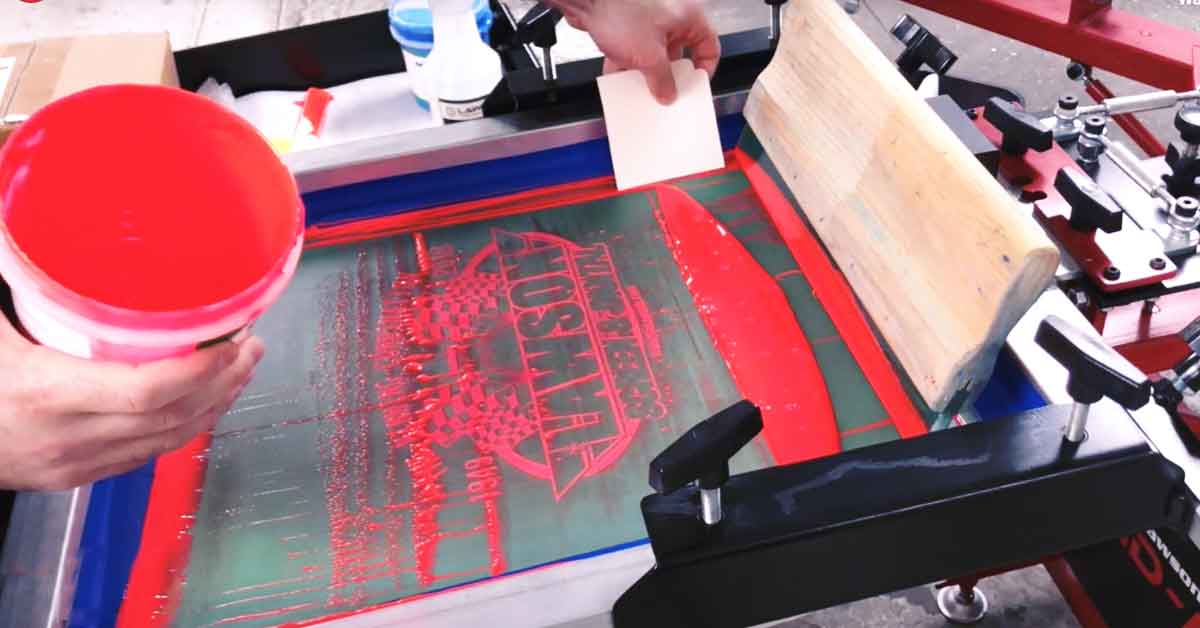Rumored Buzz on Tx Tees
Rumored Buzz on Tx Tees
Blog Article
The Single Strategy To Use For Tx Tees
Table of ContentsAbout Tx TeesWhat Does Tx Tees Do?The Best Strategy To Use For Tx TeesWhat Does Tx Tees Mean?See This Report about Tx TeesSome Ideas on Tx Tees You Need To KnowRumored Buzz on Tx Tees
Add up various other expenses, like the number of utilities it takes to run the store and the expense of ink and emulsion per layout. Take the print below.The emulsion must only be a few cents given that you 'd only need to layer one screen for this job. How much should you charge per t shirt to make a profit? Typically, printers attempt to make up to 45% earnings on a print job. Right here's a table to aid you determine that: overall expense per thing percent of desired profit as a decimal (example:.25 or.45) earnings made per thing per job Now let's discuss the profitability of DTF.

With DTF, you can publish a handful of tee shirts, or just one. Both screen printing and DTF have their particular niches in the globe.
The 15-Second Trick For Tx Tees
The very best way to understand? Ask about and see what print shops like yours are doing. custom screen printing. Attempt both out and see which you like far better
When you're picking what type of printing approach to make use of for publishing your artwork layouts on your garments, it's essential that you recognize the distinctions between these two methods so you can make the most of outcomes while decreasing costs. Screen printing is the most frequently made use of strategy for publishing layouts on textiles.
DTG printing is also called area or straight to garment printing due to the fact that it publishes just what is required as opposed to making a display as display printers do. https://forums.hostsearch.com/member.php?258490-txtees02&tab=aboutme&simple=1. Display printing works by screen filler squeegee display printing ink screen mesh display, then transferring the picture to garment using warmth and/or pressure
The DTG printer makes use of special dye-sublimation inks that are applied right into a pre-designed image by an electronic printing system. The inks enter into the material, allowing for vivid colors and remarkable information. It's also recognized as area or straight to garment printing since it publishes only what is required as opposed to making a display as screen printers do.
The Ultimate Guide To Tx Tees
Initially, it's much faster - you can publish a fullcolor image in mins, instead of hours for screen printing. Second, there's no set up time or expenses included - you can publish any kind of design you like, without having to produce a display. Third, there's no waste - due to the fact that display printers screen print one design at a time, they have to screen each color individually.
The paper is really pricey and can just be made use of once. Once it's printed on, it has to be discarded. - The preliminary purchase cost is lower than the in advance investment of DTG printers- You can print multi-color styles one screen each time as opposed to having to print each color separately like DTG printing.

An Unbiased View of Tx Tees
Nonetheless, rather than utilizing display mesh as screen printers do, color sublimation printers use laser innovation to move your pictures onto garments or paper. A warmth process transfers the color from its solid-state directly into the gas stage which in turn merges it onto textile substratums when they are rapidly heated up to high temperature levels under high pressure.
Sublimation printing is green. It uses less water than screenprinting, and due to the fact that it does not involve the use of unsafe solvents, it's safe for all kinds of apparel. The color sublimation inks are likewise odor free when treated, unlike display printers that use damaging chemicals throughout the display printing procedure that leave behind an unpleasant odor.
They likewise save cash on expensive tools like direct exposure units since dye sublimation printers don't need a UV exposure system or a flash remedy stove that is commonly made use of in display printing (custom monograming). What is straight to garment printing (DTG Printing)? DTG printing is an electronic screenprinting procedure that publishes straight onto textile making use of specialized inkjet printers
Tx Tees - The Facts
DTG printing uses numerous benefits over typical screenprinting, consisting of the capability to print photo high quality images, higher color vibrancy, and the capacity to publish designs on darker fabrics. DTG printers function by heating up the textile ink till it develops into a gas. The gas after that permeates the textile, bonding with the fibers to produce a permanent print.

Display printers just prepare their display then start printing up until they run out of product or ink.- There is a broad variety of knowledgeable display printers around the world, which can be practical for novices. - It's a slower procedure - screen printers typically need to wait on the ink to dry before they can print the following shade- Display printers need manual work, so there's a higher knowing curve and it takes longer to produce a top visit the website quality design- Display printing isn't as exact as DTG printing, so you might get some "bleeding" of shades from one component of the picture onto one more if not done properly.
3 Simple Techniques For Tx Tees
Nevertheless, as opposed to utilizing screen mesh as display printers do, dye sublimation printers make use of laser innovation to transfer your pictures onto garments or paper. A warmth process moves the dye from its solid-state straight into the gas stage which in turn merges it onto fabric substratums when they are rapidly heated up to high temperatures under high stress.
Sublimation printing is environmentally friendly. It uses less water than screenprinting, and because it doesn't include using unsafe solvents, it's risk-free for all sorts of apparel. The color sublimation inks are also odor-free when cured, unlike screen printers that make use of damaging chemicals throughout the screen printing process that leave an unpleasant odor.
They additionally save cash on expensive tools like exposure systems given that dye sublimation printers don't call for a UV direct exposure unit or a flash remedy stove that is usually utilized in screen printing. What is straight to garment printing (DTG Printing)? DTG printing is a digital screenprinting procedure that prints directly onto material making use of specialized inkjet printers.
Tx Tees Can Be Fun For Everyone
DTG printing supplies several advantages over typical screenprinting, consisting of the capacity to publish photo top quality pictures, higher color vibrancy, and the capability to print designs on darker fabrics. DTG printers function by warming the fabric ink up until it develops into a gas. The gas then penetrates the textile, bonding with the fibers to produce a long-term print.
Report this page